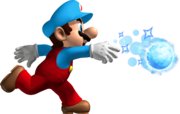New Super Mario Bros. U Deluxe: Difference between revisions
No edit summary Tag: Mobile edit |
No edit summary Tag: Mobile edit |
||
| Line 1,679: | Line 1,679: | ||
The third game update adds the ability for the game to receive the ''New Super Luigi U'' downloadable content and puts a prompt in-game to go to the Nintendo eShop to download it. The update also adds support for the Wii U Pro Controller. | The third game update adds the ability for the game to receive the ''New Super Luigi U'' downloadable content and puts a prompt in-game to go to the Nintendo eShop to download it. The update also adds support for the Wii U Pro Controller. | ||
==Development== | |||
As stated above, ''New Super Mario Bros. U'' was based upon the ''New Super Mario Bros. Mii'' Wii U experience demo shown off at E3 2011.<ref>[https://www.nintendolife.com/news/2012/04/mario_wii_u_based_on_new_super_mario_bros_mii Mario Wii U "Based On" New Super Mario Bros. Mii Wii U News @ Nintendo Life]</ref> A translation of a Spanish online magazine revealed that the new title was in development and would be revealed at {{wp|E3 2012}},<ref>[https://www.nintendolife.com/news/2012/04/miyamoto_to_show_wii_u_mario_at_e3 Miyamoto To Show Wii U Mario at E3 - Wii News @ Nintendo Life]</ref> with the game fully revealed to be ''New Super Mario Bros. U'' during the E3 trailer.<ref>[https://www.youtube.com/watch?v=K4pJnV5OxPI Wii U - ''New Super Mario Bros. U'' E3 Trailer]</ref> | |||
''New Super Mario Bros. U'' began development soon after the completion of ''New Super Mario Bros. Wii'', using pre-existing elements from the Wii game, as development equipment for the Wii U did not exist at the time.<ref name="Iwata NSMBU 1">[https://iwataasks.nintendo.com/interviews/#/wiiu/nsmbu/0/0 Iwata Asks : ''New Super Mario Bros. U'' : "What Should Be New?"]</ref> The game's singular, interconnected world map was inspired by the one seen in ''Super Mario World''; Masataka Takemoto desired to take the map from that game and use the Wii U in order to recreate and expand upon the concept.<ref name="Iwata NSMBU 3">[https://iwataasks.nintendo.com/interviews/#/wiiu/nsmbu/0/3 Iwata Asks : ''New Super Mario Bros. U'' : One Map]</ref> The map being seamless also had a role in Miiverse integration, as with the setup of the map it was possible to display comments across each of the levels.<ref name="Iwata NSMBU 4">[https://iwataasks.nintendo.com/interviews/#/wiiu/nsmbu/0/4 Iwata Asks : ''New Super Mario Bros. U'' : Reading the Posts in your Hands]</ref> The concept of drop-in play with one player on the Gamepad placing blocks was brought up early in development. When the Wii U Gamepad was brought up during development, the team began to conceptualize ways to use it, talking specifically about the drop-in play. Wanting to make a feature with "controls that you can understand right away with no explanation," the concept of using the GamePad to place blocks the other players can jump on went through.<ref name="Iwata NSMBU 1"></ref> | |||
Challenge Mode was based upon the idea of setting a self-challenge in the previous games, as well as the challenge site for ''New Super Mario Bros. Wii''. Because of ideas like this, the developers decided to put the Challenge Mode into the game from the beginning. The challenges were created with all types of skill levels in mind.<ref name="Iwata NSMBU 2">[https://iwataasks.nintendo.com/interviews/#/wiiu/nsmbu/0/1 Iwata Asks : ''New Super Mario Bros. U'' : "Mottainai (What a Waste)!"]</ref> | |||
Boost Rush Mode was based on the Free-for-All Mode featured in ''New Super Mario Bros. Wii'', in that they wanted a similar mode for playing the main game stages in short bursts. The developers tried connecting courses together and playing them through, but found it uneventful; they then added the concept of collecting coins resulting in the screen scrolling faster, and found it to fit a ''Super Mario''-style of gameplay.<ref name="Iwata NSMBU 3"></ref> | |||
==Pre-release and unused content== | ==Pre-release and unused content== | ||
Revision as of 01:13, May 13, 2024
- This article is about the Nintendo Switch port of the New Super Mario Bros. U game. For the game's original version, see New Super Mario Bros. U.
- Not to be confused with Super Mario Bros. Deluxe or New Super Mario Bros. U + New Super Luigi U.
| New Super Mario Bros. U Deluxe | |||||||||||||||||||||||||||
|---|---|---|---|---|---|---|---|---|---|---|---|---|---|---|---|---|---|---|---|---|---|---|---|---|---|---|---|
 North American box cover For alternate box art, see the game's gallery. | |||||||||||||||||||||||||||
| Developer | Nintendo EPD | ||||||||||||||||||||||||||
| Publisher | Nintendo Tencent Games (China) | ||||||||||||||||||||||||||
| Platform(s) | Nintendo Switch | ||||||||||||||||||||||||||
| Release date | Template:Release[?] | ||||||||||||||||||||||||||
| Language(s) | English (United Kingdom) English (United States) French (France) French (Canada) German Spanish (Spain) Spanish (Latin America) Italian Dutch Portuguese (Portugal) Russian Japanese Simplified Chinese1 Traditional Chinese Korean 1 - The global and domestic versions have slightly different localizations. | ||||||||||||||||||||||||||
| Genre | Platformer | ||||||||||||||||||||||||||
| Rating(s) |
| ||||||||||||||||||||||||||
| Mode(s) | Single player, multiplayer | ||||||||||||||||||||||||||
| Input | Nintendo Switch:
| ||||||||||||||||||||||||||
New Super Mario Bros. U Deluxe is a side-scrolling 2.5D platform game released on the Nintendo Switch worldwide on January 11, 2019; it is the last Super Mario game to be released during the Heisei era of Japan, coming out three and a half months before the abdication of emperor Akihito. It is a port of the 2012 Wii U launch title New Super Mario Bros. U. It contains both the base game and the New Super Luigi U DLC. Mario, Luigi, Yellow Toad, Blue Toad (both generically named Toad in this game), and Nabbit all return as playable characters from the original Wii U title while this game introduces a new playable character, Toadette, who makes her playable debut in the New Super Mario Bros. games and replaces Blue Toad in the story. She has a unique form known as Peachette, which she obtains after grabbing a new item called the Super Crown. The Peachette form grants her abilities similar but not identical to those of the Flying Squirrel form.
Story
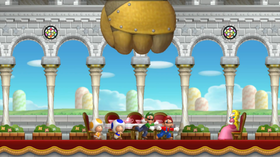
Mario, Luigi, Yellow Toad, and Blue Toad are with Princess Peach in Peach's Castle dining together. Bowser and the Koopalings suddenly arrive in their Airships, with the former sporting a Mecha Hand that smashes and launches the brothers and the Toads away from the castle. Mario and his friends crash into the Acorn Tree, launching Super Acorns through the area. They then tumble out of the tree, passing by a Bubble Baby Yoshi and Balloon Baby Yoshi, and they then look into the horizon to see Bowser beginning a siege on Princess Peach's Castle, setting the Mario Bros. and the Toads to go on a new adventure and to save Princess Peach.
As the game progresses, the view occasionally shifts to Peach's Castle, showing the flags being replaced by Bowser's flags (after Tilted Tunnel), and the castle being surrounded by a thin tornado-like cloud that is made thicker by Magikoopa's magic (after Stoneslide Tower), entirely obscuring the castle (after Giant Skewer Tower or Freezing-Rain Tower). Mario, Luigi, Yellow Toad, and Blue Toad also encounter Bowser's forces, including the Koopalings, Boom Boom, Magikoopa, and Bowser Jr., who occasionally attacks the heroes with his father's airship. All of them are defeated, and Bowser Jr. causes the airship to crash after making the mechanical hand punch through it. After reaching Peach's Castle and defeating Bowser, the group moves onward, but Bowser Jr. appears and urges Magikoopa to spread his magic across the area. After heading to the castle exterior, Mario and the others see Peach in a tower. Before they can save her, she is locked inside the tower and Bowser appears, now at a giant size, alongside Bowser Jr. Eventually, Bowser is defeated and Bowser Jr., embarrassed, flees. The character that defeated Bowser gets to Peach and bows down to her, and is then kissed by her, to their shock and delight, as the clouds surrounding the castle disappear, restoring it to its former state.
Outside the castle, the Koopalings and Bowser Jr. are fleeing on the airship as Bowser, who has returned to his normal size, recovers. Noticing the escaping airship, he climbs up onto one of the castle towers and leaps onto the ship, but his weight causes it to plummet into a hill nearby; they then fly away hanging onto Bowser Jr.'s Junior Clown Car while Mario and Blue Toad watch. They then turn back to the others, who are celebrating their victory, with Mario delivering a final victory pose.
Gameplay features
New Super Mario Bros. U is a platform game which plays very similarly to that of past New Super Mario Bros. games, especially New Super Mario Bros. Wii, with the return of the 4-player multiplayer functioning identically to the Wii game, while most of the elements and design found in the game make heavy reference to Super Mario World. Many other gameplay elements from the Wii game, such as the Super Guide, Enemy Courses, and the bubble function, also return. In certain modes, players can play as their Miis, including the first player, who can also choose whoever to play as. Power-ups, like the Fire Flower, Ice Flower, Penguin Suit, Propeller Mushroom, and the Mini Mushroom return. The game also features a new power-up, the Super Acorn, which gives Mario and co. a Flying Squirrel form, which lets them glide and grab on to walls.
New Super Mario Bros. U features two main controller options: single player using the Wii U GamePad, and single-player or multiplayer using Wii Remotes and/or Wii U Pro Controllers; the player can switch controllers at any point between the GamePad and a Wii Remote or Pro Controller by pausing the game, either in a level or on the world map, and selecting the "Change Controller" option. The game supports up to five simultaneous players, with up to four being able to play as the characters with a Wii Remote or Wii U Pro Controller, and are able to drop in and out at any point while in a stage by pressing ![]() on the GamePad and selecting a character, or on the map by pausing and selecting "Number of Players". Another player is able to use the Wii U GamePad in what is known as Boost Mode. In Boost Mode, the GamePad player can assist the other players by placing blocks for them to stand on and stunning enemies. Boost Mode can be used at any point when playing with one of the other controllers; when playing with just the GamePad, it supports Off-TV Play.
on the GamePad and selecting a character, or on the map by pausing and selecting "Number of Players". Another player is able to use the Wii U GamePad in what is known as Boost Mode. In Boost Mode, the GamePad player can assist the other players by placing blocks for them to stand on and stunning enemies. Boost Mode can be used at any point when playing with one of the other controllers; when playing with just the GamePad, it supports Off-TV Play.
After clearing Layer-Cake Desert-1, an enemy called Nabbit appears and steals an item from a Toad House connecting that level, heading back to Acorn Plains-1. When the player enters a stage with Nabbit, the objective is to race him to the goal, trying to catch him before he can get away. If the player succeeds in catching Nabbit, they are rewarded with a P-Acorn. Replacing the Toad saving in New Super Mario Bros. Wii, Nabbit only appears in one stage in the first seven worlds.
The first update to the game added Miiverse support. With Miiverse functionality enabled, players can read each others' posts on the world map by viewing the map; when not viewing the map a Miiverse post is indicated by a red balloon, generally near a stage, and can be hidden by pressing ![]() ; when on the World Map while using Boost Mode, the GamePad player can scroll across the map on the GamePad screen and view Miiverse posts. At certain times throughout gameplay, such as when the player dies several times or reaches the end of a course in a specific way (collecting all the Star Coins, clearing in a certain amount of time, clearing without taking damage, etc.), they are given a prompt to post a message to Miiverse. Players can also see Miiverse posts after they die in a stage. Miiverse settings can be changed at any point on the world map by selecting the pencil and envelope icon on the bottom right of the pause menu.
; when on the World Map while using Boost Mode, the GamePad player can scroll across the map on the GamePad screen and view Miiverse posts. At certain times throughout gameplay, such as when the player dies several times or reaches the end of a course in a specific way (collecting all the Star Coins, clearing in a certain amount of time, clearing without taking damage, etc.), they are given a prompt to post a message to Miiverse. Players can also see Miiverse posts after they die in a stage. Miiverse settings can be changed at any point on the world map by selecting the pencil and envelope icon on the bottom right of the pause menu.
The sound is in stereo, with no support for 5.1 surround.
Controls
Like New Super Mario Bros. Wii, the Wii Remote is the primary controller for the game, allowing players to shake the controller to perform a Spin Jump, dismount Yoshi, and pick up objects. However, players can also play the game normally with the Wii U GamePad (single-player only) or the Wii U Pro Controller (after the 1.3.0 update). In the case of the Wii U Pro Controller, actions that require motion control on the Wii Remote and Wii U GamePad are replaced with button pressing, as the Wii U Pro Controller lacks motion controls.
Unlike New Super Mario Bros. Wii, this game lacks Nunchuk support.
Stages
| Action(s) | Wii U GamePad | Wii U Pro Controller | Wii Remote |
|---|---|---|---|
| Move, swim (Baby Yoshi) | |||
| Jump, swim, glide (hold), wall jump, Flutter Jump (Yoshi; hold), double/triple jump (press right upon landing) | Option 1: Option 2: |
||
| Run, carry objects (hold); shoot fireballs/iceballs, extend tongue (Yoshi) | Option 1: Option 2: |
||
| Ground Pound (normal, simultaneous*) | Jump + |
||
| Crouch, slide (on slopes) | |||
| Climb (on fences, ladders, poles) | |||
| Bubble* | N/A | ||
| Enter door/Warp Pipe | Door: Pipe: |
Door: Pipe: | |
| Spin Jump, Baby Yoshi abilities, dismount Yoshi, Flying Squirrel jump, spin underwater (Baby Yoshi) | |||
| Grab other players*/frozen enemies | Run + (release run button to throw) |
Run + (release run button to throw) |
(release |
| Tilt Tilt Lifts | Tilt GamePad | Alternate between pressing |
Tilt Wii Remote |
| Pause | |||
| Boost Mode* | N/A | ||
* Multiplayer only.
| Action(s) | Wii U GamePad/Pro Controller | Wii Remote |
|---|---|---|
| Move, select option | ||
| Open inventory | ||
| View map | ||
| Pause | ||
| Zoom in/out (map view) | ||
| Confirm, hide/show Miiverse posts (map view) | ||
| Back | ||
Worlds
Unlike the previous New Super Mario Bros. titles, where worlds are separated like in Super Mario Bros. 3, New Super Mario Bros. U has a contiguous world map, similar to Super Mario World. Like New Super Mario Bros. Wii, the worlds include Toad Houses and Enemy Courses, though only red and green Toad Houses return. Also returning are Towers, Castles, and Ghost House-related levels. The music changes instruments throughout the world map similar to Yoshi's Island.
This is the first 2D Super Mario game to use completely unique names for each of its levels, and the second after Super Mario World to name its greater areas in-game. Both games use food and beverages as the theme for their world names.
Other areas
| Template:Color-link | Template:Color-link | |
|---|---|---|
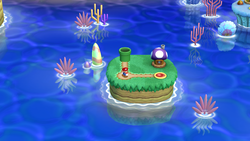
|
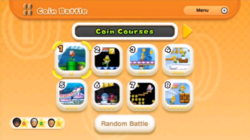
| |
| A small island between Acorn Plains and Sparkling Waters that houses a Purple Toad House, where the player can check several records. It is unlocked alongside Superstar Road. | A multiplayer-exclusive world found in Coin Battle, similar to World Coin from New Super Mario Bros. Wii. | |
| # | Difficulty | |
| Template:World-link | ★ | |
| Template:World-link | ★ | |
| Template:World-link | ★★ | |
| Template:World-link | ★★★ | |
| Template:World-link | ★★★ | |
| Template:World-link | ★★★★ | |
| Template:World-link | ★★★★★ | |
| Template:World-link | ★★★★★ | |
Yoshis
Green Yoshis make a return, acting like in New Super Mario Bros Wii. Green is the only color available for Yoshis that the players ride on, unlike New Super Mario Bros. Wii. Yoshi now has a meter that tracks how many fruits he eats, instead of showing a number each time he eats one. As usual, eating 5 makes him lay an egg containing an item. Like in New Super Mario Bros. Wii, Yoshi cannot leave the courses that he appears in.
New Super Mario Bros. U also features the return of Baby Yoshis, having been absent from the Super Mario series since their debut in Super Mario World. The game features three differently-colored Baby Yoshis, each one with a special ability. They differ from the adult Green Yoshi in terms of gameplay. Being babies, they cannot be ridden, so characters must carry them throughout the levels. Baby Yoshis also instantly eat almost any enemy that is in front of them. Unlike in Super Mario World, however, Baby Yoshis no longer grow into adults after eating several enemies, instead remaining as babies. Two types of Baby Yoshis found on the overworld can be taken into any course, with the exception of Fortresses, Airships, and Castles.
| Baby Yoshi | Description |
|---|---|
 Bubble Baby Yoshi |
Blue Baby Yoshis that blow bubbles from their mouths. Enemies caught in these bubbles will turn into 3 Coins, a power-up or a 1-Up Mushroom. These bubbles can also be used as miniature platforms. They first appear on the Frosted Glacier map area. |
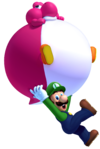 Balloon Baby Yoshi |
Magenta Baby Yoshis that expand like balloons and gently float in the air. These Baby Yoshis are similar to the Blimp Yoshi power-up, found in Super Mario Galaxy 2. They first appear on the Acorn Plains map area. Additionally, up to 4 players can grab on to one Baby Yoshi, by grabbing their legs. This slows the player down though. |
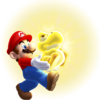 Glowing Baby Yoshi |
Yellow Baby Yoshis that light up dark areas and can stun enemies with their light attack. These Baby Yoshis act similar to the Light Blocks, found in New Super Mario Bros. Wii, and also Bulb Yoshi from Super Mario Galaxy 2. Unlike the other two Baby Yoshis, the Glowing Baby Yoshis are not found on the world map, and are only found in courses such as Perilous Pokey Cave. Instead of following the characters throughout the courses, they give an extra life when reach the end of the levels that they appear in. |
Inventory
The world map inventory, seen in Super Mario Bros. 3 and New Super Mario Bros. Wii, returns in New Super Mario Bros. U, allowing players to store items that can be used before entering a level. Unlike the other inventories, this is limited to ten items only. If more items come in, the player will have to discard items from the inventory until they have ten. Players can gain items into their inventory by playing Red Toad House minigames, collecting items on the world map itself, completing an Enemy Course, catching Nabbit, or finishing a level with the final two digits of the time matching.
Extra modes
In addition to the main adventure, New Super Mario Bros. U features three additional bonus modes to play. The first of these is Challenge Mode, in which players must complete a given objective on a given stage, some within a specific time limit. In most cases, after the player completes a challenge, they are ranked with a medal depending on how well they did. There are five types of challenges: Time Attack, Coin Collection, 1-Up Rally, Special, and Boost Mode.
Another mode is Boost Rush Mode, where players have to reach the end of two or three selected stages in the lowest possible time, similar to the Coin Rush mode featured in New Super Mario Bros. 2. Unlike Coin Rush, the stages scroll automatically, meaning the player has to keep up with the stage, which speeds up every time they collect coins.
Coin Battle from New Super Mario Bros. Wii is also available. However, in this version of the mode, players can be grouped into teams against each other or play free-for-all, rather than just the latter. The Wii U GamePad can also be used for Coin Edit, in which the GamePad is used to customize the coin placement in the Coin Battle-exclusive courses.
Unlike in the main game, player 1 can choose any character in these modes.
Characters
Playable
- NSMBU Nabbit
- Artwork.png
- (character)
Nabbit]]
Bosses
Tower bosses
| Boss | Description |
|---|---|
 Boom Boom |
The tower boss from Acorn Plains to the first tower of Rock-Candy Mines. He does not change in the first battle. However, following his first defeat, Magikoopa gives him special abilities. In Layer-Cake Desert, Magikoopa will grant him the ability to spin jump. In Frosted Glacier and Sparkling Waters, Magikoopa will grant him the ability to jump, similar to Super Mario Bros. 3. In Soda Jungle, Magikoopa will make him larger. In Rock-Candy Mines, Magikoopa will transform his arms into wings, similar to Super Mario Bros. 3. |
 Boss Sumo Bro |
Boss Sumo Bro was a regular Sumo Bro until Magikoopa made him grow in size. He is normally immune to attacks from the top due to the spike on his head, but he will jump between platforms which the player can hit from the bottom. Knocking him off a platform makes him vulnerable to jump attacks. He is fought on Screwtop Tower. |
 Magikoopa |
Magikoopa is fought on Slide Lift Tower and teleports most of the time when Mario gets too close. However, when he stops to attack Mario, he is left vulnerable to Mario's jumping. He also casts spells on Boom Boom, Boss Sumo Bro, and Bowser granting them extra power before their battles, such as causing them to grow in size. |
Castle/airship bosses
| Boss | Description |
|---|---|
 Lemmy Koopa |
Lemmy Koopa is fought on Lemmy's Swingback Castle in Acorn Plains and attempts to throw bombs at Mario. |
 Morton Koopa Jr. |
Morton Koopa Jr. is fought on Morton's Compactor Castle in Layer Cake Desert and uses a large hammer that is apparently filled with magic to knock giant Pokey segments in the player's way after shaking the ground by stomping on it. He can knock Pokey segments straight at the player or knock them in high arcs. |
 Larry Koopa |
Larry Koopa is fought on Larry's Torpedo Castle in Sparkling Waters and blasts fireballs and use water blasts from the pool below the arena. When Larry is spinning in his shell, the water geysers give his shell a boost upwards, making it a bit tricky to avoid. After two stomps, Larry begins to cast two fireballs in quick succession. |
 Wendy O. Koopa |
Wendy O. Koopa is fought on Wendy's Shifting Castle in Frosted Glacier and skates around the arena, shooting out two energy rings that ricochet off of walls and can knock down the icicles at the ceiling of the airship. She also spin jumps from walls. After she is jumped on twice, she will shoot out three rings instead. |
 Iggy Koopa |
Iggy Koopa is fought on Iggy's Volcanic Castle in Soda Jungle and uses the four warp pipes to run around the room and on the ceiling to make it trickier for the player to stomp on him as he uses his Magic Wand to shoot three fireballs, with some being his usual green flame, and the other being red skeleton orbs that generate Magmaarghs when they land into the lava below. When Iggy is stomped on, he will dash around the room in his shell using the pipes on the walls, which will switch him to the other side of the room. Unlike the other Koopalings where they spin in their shells and change directions at the edges or walls of the room, Iggy can actually change directions anywhere around the room during his duration in his shell. |
 Roy Koopa |
Roy Koopa is fought on Roy's Conveyor Castle in Rock-Candy Mines and shoots Bullet Bills with his cannon and jump between platforms that move around during the fight. Occasionally, he shoots Missile Bills. He can also jump high in the air and ground pound the floor or platform, which makes him fire Bullet Bills on both sides of his blaster. The ground pound can also make the floating platforms appear after he comes out of his shell. |
 Ludwig von Koopa |
Ludwig von Koopa is fought on Ludwig's Clockwork Castle in Meringue Clouds and levitates in the air while making two clones of himself, and all three Ludwigs will blast fireballs at Mario before dropping onto the ground. If one of the clones is jumped on, it will simply disappear. There are four ways to find out which is the real one. The one that is the real one fires three fireballs, while the clones fire two. The clones keep their eyes half-open, and tend to assume the real Ludwig's pre-battle idle pose while not levitating. The real Ludwig will also drop to the ground last, after the clones, as well as laugh while dropping. Finally, Mario always looks at the real Ludwig if he can see him directly, just as he does with the other bosses. When the fight starts off, after shooting their fireballs, the clones disappear before landing. After the first stomp, the clones do not disappear. After the second stomp, not only do all three Ludwigs shoot faster, but swap positions, though the real Ludwig still shoots three fireballs. |
 Bowser Jr. |
Bowser Jr. is fought on airships. In Soda Jungle's The Mighty Cannonship, Bowser Jr. uses his Junior Clown Car as a submarine underwater, in which the player must guide the Targeting Teds that Bowser Jr. shoots into his submarine. With every hit, he summons three Torpedo Teds from the left and right or from the ceiling and the floor. In Meringue Clouds' Boarding the Airship, Bowser Jr.'s boss battle involves him in his Clown Car equipped with boxing gloves, which he uses to destroy the blocks the player is standing on. Bowser Jr. periodically throws Bob-ombs, which the player can use against him. However, in Peach's Castle's The Final Battle, he cannot be defeated. |
 Bowser |
Bowser is fought in The Final Battle in Peach's Castle. The first part of his battle is similar to Super Mario Bros., where the player has to get to the other side and press the switch; alternatively, shooting several fireballs also works. This causes the axe to fall and make the bridge collapse, making Bowser fall. The gate then opens and Mario moves on. When Mario reaches the top of the castle, Peach is being held up in the tower. After this, Bowser Jr. shows up in his Junior Clown Car, and Bowser hops on top of the castle while he is huge. Bowser Jr. also fights the player. In order to defeat them, the player must jump on Bowser Jr., causing him to fall out of his Junior Clown Car. This allows the player to jump in and hover over Bowser to harm him. Like the Koopalings, he curls into his shell and spins around when hit. He is defeated after being hit three times by the Clown Car. |
Supporting
Other
Transformations
(starting form) |
( |
(New, |
( |
( |
( |
( |
(New, |
( |
( |
Enemies and obstacles
New Enemies
| Enemy | Description | First appearance | Last appearance |
|---|---|---|---|
 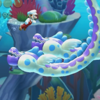 Dragoneel |
A dragon-like eel that attacks Mario by chasing him. Shorter, purple ones also exist that move slower, but make sharper turns. | Dragoneel's Undersea Grotto (red/purple) | |
 Fliprus |
A walrus-like creature that throws snowballs that can be jumped on. | Fliprus Lake | |
 Goombrat |
A Goomba that resembles a persimmon and turns at ledges. | Mushroom Heights | |
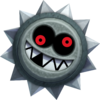 Grrrol |
A sub-species of Thwomp that roll on the ground. | Stoneslide Tower | Grinding-Stone Tower |
 Mecha Cheep |
Robotic Cheep Cheeps that are immune to fireballs. | The Mighty Cannonship | |
 Mega Grrrol |
A bigger Grrrol that rolls around. | Grinding-Stone Tower | |
 Piranha Pod |
A projectile thrown by a Lakitu that turns into a Piranha Plant. | Blooming Lakitus | |
Targeting Ted |
Red Torpedo Teds that home into their target, much like Missile Bills. | The Mighty Cannonship | |
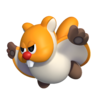 Waddlewing |
Orange flying-squirrel enemies that glide through stages. | Acorn Plains Way | Land of Flying Blocks |
Returning Enemies
It has been requested that at least one image be uploaded for this section. Remove this notice only after the image(s) have been added. Specifics: better images for Blooper, Circling Boo Buddies, Dry Bones, Lava Bubble, Mini Goomba, Spiny, Stone Spike, Stalking Piranha Plant, Swoop should be uploaded.
Enemies with an asterisk (*) are enemies that first appeared in New Super Mario Bros. Wii. The only two enemies that do not reappear are the Ghost Vase and the Bull's-Eye Bomber Bill.
| Image | Name | Description | First appearance | Last appearance |
|---|---|---|---|---|

|
Amp | Electric balls that shock Mario upon contact. | Snake Block Tower | Ludwig's Clockwork Castle |

|
Bomber Bill | Large Bullet Bills that fly straight forward. | Scaling the Mountainside | |
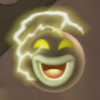
|
Big Amp | Larger variants of Amps. | Snake Block Tower | |
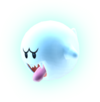
|
Big Boo | Bigger variants of Boos that have the same behavior. | Swaying Ghost House | Spinning Spirit House |

|
Big Buzzy Beetle | Bigger variants of Buzzy Beetles. | Rising Tides of Lava | |

|
Big Cheep Cheep | Large variants of Cheep Cheeps that are found in underwater levels. | Tropical Refresher | |
| Big Dry Bones | Large variants of Dry Bones that appear in castle levels. | Stoneslide Tower | Ludwig's Clockwork Castle | |

|
Big Fuzzy* | Large variants of Fuzzies. | Spine-Tingling Spine Coaster | |

|
Big Goomba | Large variants of Goombas. They split into two Hefty Goombas once stomped on. | Jungle of the Giants | |

|
Big Koopa Troopa | Large variants of Koopa Troopas. | Jungle of the Giants | |

|
Big Piranha Plant | Large variants of Piranha Plants. | Mushroom Heights | A Quick Dip in the Sky |

|
Big Pokey | Large variants of Pokeys. | Morton's Compactor Castle | |
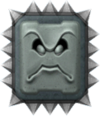
|
Big Thwomp | Large Thwomps that can break through stone tiles. | Wendy's Shifting Castle | |

|
Big Urchin* | A gigantic Urchin that can be defeated only with a Star. | Tropical Refresher | Urchin Shoals |
| Big Wiggler | Large variants of Wigglers. | Wiggler Stampede | ||
| Blooper | Underwater enemies that move in an erratic pattern and follow Mario. | Blooper's Secret Lair | Tropical Refresher | |
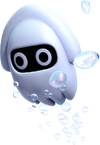
|
Blooper Baby | Small Bloopers that follow Blooper Nannies. | Blooper's Secret Lair | |
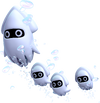
|
Blooper Nanny | Bloopers that have Blooper Babies swimming in a trail behind them. | Blooper's Secret Lair | |
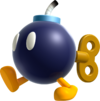
|
Bob-omb | Bombs that ignite if they are jumped on or have a fireball thrown at them, then explode shortly after. | Light Blocks, Dark Tower | The Final Battle |
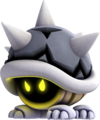
|
Bony Beetle | Skeleton variants of Buzzy Beetles that walk around and suddenly stop to stick out their spikes. | Grinding-Stone Tower | Pendulum Castle |
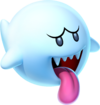
|
Boo | Ghosts that follow Mario when his back is turned, but hide their face when he looks at them. | Haunted Shipwreck | Spinning Spirit House |

|
Boomerang Bro | Hammer Bros. that use boomerangs, which return to them after being thrown. | Bouncy Cloud Boomerangs | |

|
Bramball* | An enemy that moves around in a set pattern and is mostly covered in spikes, with the head being the only safe part to jump on. It can be forced to move if jumped into from below. | Bramball Woods | |

|
Broozer | A walking, boxing Boo. Can break bricks and other blocks that are normally indestructible. Mario can defeat it by jumping on it three times, or hitting him with a fireball. | Which-Way Labyrinth | Spinning Spirit House |

|
Bulber* | An enemy that illuminates a dark area and swims in a set pattern. | Deepsea Ruins | |
| Bullet Bill | Bullets that fly straight forward and are shot from Bill Blasters and Bill Blaster Turrets. | Scaling the Mountainside | Switchback Hill | |

|
Buzzy Beetle | Shelled enemies that can be kicked or thrown after being jumped on, and can walk on ceilings. | Tilted Tunnel | Fire Bar Cliffs |
| Chain Chomp | Enemies tied to posts that lunge at Mario. If Mario ground pounds their post, they are set free. | Waddlewing's Nest | ||

|
Cheep Cheep | Fish that are found swimming aimlessly in underwater levels. | Waterspout Beach | Swim for Your Life! |

|
Cheep Chomp | Large fish that attempt to eat Mario. | Swim for Your Life! | |
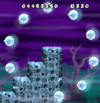
|
Circling Boo Buddies | Boos flying in a circle formation. | Haunted Shipwreck | Spinning Platforms of Doom |

|
Clampy | Clams that open and close their mouths. | Waterspout Beach | |

|
Cooligan* | An enemy that slides on ice and slows down when hit. | Cooligan Fields | |

|
Dry Bones | Skeleton Koopa Troopas that collapse when attacked, but later rebuild themselves. | Crushing-Cogs Tower | Ludwig's Clockwork Castle |

|
Eep Cheep* | A Cheep Cheep that lives in a school with other Eep Cheeps and swims away when the player comes near it. | Dragoneel's Undersea Grotto | |

|
Fire Bro | Hammer Bros. that throw fireballs. | Fire Snake Cavern | Ludwig's Clockwork Castle |

|
Fire Piranha Plant | Piranha Plants that aim at Mario and shoot fireballs. | Yoshi Hill | Prickly Goombas! |

|
Fire Snake | Flames that jump in a high arc. | Fire Snake Cavern | |

|
Fish Bone | Skeletal fish that charge towards Mario. | Haunted Shipwreck | Deepsea Ruins |

|
Flame Chomp | Black spheres that spit fireballs at Mario. They explode after they're out of fireballs. | Rising Tides of Lava | |

|
Foo* | An enemy that creates fog in order to obscure the player's view. | Snaking above Mist Valley | |

|
Frost Piranha | A Piranha Plant that can shoot ice balls from its mouth, like Fire Piranha Plants. | Fuzzy Clifftop | |

|
Fuzzy | Enemies that follow tracks and hurt Mario upon contact. | Fuzzy Clifftop | A Quick Dip in the Sky |
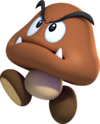
|
Goomba | Common enemies that can be defeated by jumping on them. | Acorn Plains Way | Follow That Shell! |
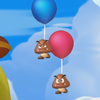 Goomba (balloon) |
Goombas with balloons on them that float down the stage. | Skyward Stalk | ||

|
Hammer Bro | Enemies that throw hammers and jump. | Rise of the Piranha Plants | |
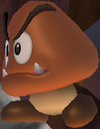
|
Hefty Goomba* | A large Goomba that is the middling size of a Goomba, being smaller than a Giant Goomba but bigger than a regular Goomba. This enemy splits into two Goombas when jumped on. | Jungle of the Giants | |

|
Heavy Para-Beetle* | A Para-Beetle that descends when used as a platform. | Flight of the Para-Beetles | |
| Huckit Crab* | A crab that throws sand balls on loop. These balls can be jumped on and used as a temporary platform. | Waterspout Beach | ||

|
Ice Bro* | An enemy that throws ice balls at the ground, which can freeze the player and even other enemies. | Icicle Caverns | |
| Jellybeam* | An enemy that illuminates a dark cave. | Deepsea Ruins | ||
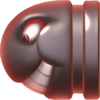
|
King Bill* | A nearly invincible enemy that charges forward, taking up most of the screen. | Flight of the Para-Beetles | |
 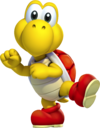
|
Koopa Troopa | Turtle enemies that go into their shells when attacked, then can be picked up or thrown. Green Koopa Troopas walk off ledges, while Red Koopa Troopas turn around. | Acorn Plains Way | Follow That Shell! |

|
Lakitu | Enemies that throw Spiny Eggs. If Mario defeats a Lakitu, he can ride on its cloud until it disappears. | Blooming Lakitus | Lakitu! Lakitu! Lakitu! |

|
Lava Bubble | Fireballs that jump out of lava. | Lemmy's Swingback Castle | The Final Battle |

|
Magmaargh | Lava monsters that attacks by moving towards the players in a wave-like movement | Iggy's Volcanic Castle | |

|
Magmaw | Lava monsters that lunges at the player and dips back into the lava. | Magma-River Cruise | |

|
Mechakoopa | A mechanical Koopa. After stomping it, Mario can pick it up and use it as a weapon. | The Mighty Cannonship | |

|
Mini Goomba | Small Goombas that weigh Mario down until he either attacks or walks for a few seconds. | Slide Lift Tower | Magma-River Cruise |

|
Missile Bill | Bullet Bills that target Mario. | Roy's Conveyor Castle | |

|
Monty Mole | A mole that pops out of mountains and the ground and gives chase. | Yoshi Hill | Magma-River Cruise |
| Muncher | An invincible black plant. | Spinning-Star Sky | Thrilling Spine Coaster | |

|
Para-Beetle | Para-Beetles are winged Buzzy Beetles. However, Mario can hop on their back for a ride, unlike with other winged foes. | Flight of the Para-Beetles | |
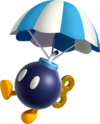
|
Parabomb | Parachuting Bob-ombs that are sometimes shot out of cannons. | Red-Hot Elevator Ride | |

|
Paragoomba | Winged Goombas that hop as they walk. | Seesaw Shrooms | |
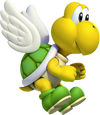 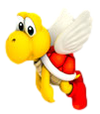
|
Paratroopa | Winged Koopa Troopas that either jump in high arcs or fly up and down in the air. | Stone-Eye Zone | Hammerswing Caverns |
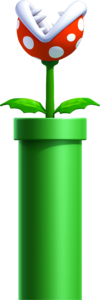
|
Piranha Plant | Plants that move in and out of Warp Pipes and some grounded. | Acorn Plains Way | Spinning Platforms of Doom |

|
Pokey | Living cacti that appear in desert levels and move slowly. | Perilous Pokey Cave | |

|
Porcupuffer | Fish that jump out of the water and follow Mario. | Porcupuffer Falls | |

|
Prickly Goomba* | A Goomba that hides inside a spiked chestnut shell until it is hit with a fireball, which is when it turns into a regular Goomba. | Prickly Goombas! | |
| River Piranha Plant* | A stationary Piranha Plant that blows a green spiked ball up and down, similar to a Ptooie. | Fliprus Lake | Seesaw Bridge | |
| Rocky Wrench | Monty Moles that pop out of its hole in an airship throw wrenches. | Boarding the Airship | ||

|
Scaredy Rat* | An enemy that walks around in a group. When one of the rats is jumped on, the rest panic and run around. | Which-Way Labyrinth | |

|
Sledge Bro | Hammer Bro variants that stun Mario after they jump. | Ludwig's Clockwork Castle | |

|
Spike | Green turtles which pull spiked balls out of their mouths and throw them directly downwards from the ledges on which they stand | Spike's Spouting Sands | |
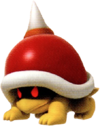
|
Spike Top | Buzzy Beetle variants that have spikes on their shells, preventing them from being jumped on. | Stoneslide Tower | Rising Tides of Lava |
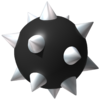
|
Spiked ball | Spike balls that appear in fortress and castle levels. | Spike's Spouting Sands | |

|
Spinner | A large spiked ball on a chain that cannot be defeated. | Snake Block Tower (regular) Pendulum Castle (large) |
Pendulum Castle (regular/large) |

|
Spiny | Enemies that hatch from Spiny Eggs and cannot be jumped on. | Seesaw Shrooms | Lakitu! Lakitu! Lakitu! |

|
Spiny Cheep Cheep | Fast-swimming fish that chase Mario. | Tropical Refresher | Swim for Your Life! |
| Stalking Piranha Plant* | A Piranha Plant that walks around and stretches up and down on a regular basis. | Bramball Woods | Walking Piranha Plants! | |

|
Stone Spike* | A Spike that throws stone rocks downwards. | Dry Desert Mushrooms | |
| Sumo Bro | Giant Koopas that stomp the ground and create electric waves in two directions. | Screwtop Tower | ||
| Swoop | Bats that hang onto the ceiling, then swoop towards Mario. | Perilous Pokey Cave | Shifting-Floor Cave | |

|
Thwimp | A tiny Thwomp that hops around. | Wendy's Shifting Castle | |
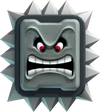
|
Thwomp | Large rocks that fall when Mario gets close. | Wendy's Shifting Castle | |

|
Torpedo Ted | A slow-moving torpedo that flies in one direction. | Larry's Torpedo Castle | The Mighty Cannonship |

|
Urchin | Stationary enemies that appear in underwater levels. | Tropical Refresher | Swim for Your Life! |
| Wiggler | Caterpillars that move faster after being jumped on. | Seesaw Bridge | Wiggler Stampede | |
Obstacles
It has been requested that at least one image be uploaded for this section. Remove this notice only after the image(s) have been added. Specifics: giant cannon
| Image | Enemy | Description | First appearance | Last appearance |
|---|---|---|---|---|
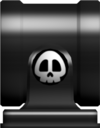
|
Banzai Bill Cannon | Cannons that shoot Banzai Bills. | ||

|
Bill Blaster | Cannons that shoot Bullet Bills. | Scaling the Mountainside | Switchback Hill |
| Bill Blaster Turret | Stacks of Bill Blasters that rotate and shoot Bullet Bills. | Switchback Hill | ||
 Bowser Stunners |
An electric statue that resembles Bowser's head and carries electrical currents. | Red-Hot Elevator Ride | ||

|
Burner | Constant streams of fire that rotate and are found on airships. | Larry's Torpedo Castle | Boarding the Airship |

|
Cannon | Cannons that shoot cannonballs or Bob-ombs. | The Mighty Cannonship | |

|
Cannonball | Heavy metal spheres launched by cannons. | The Mighty Cannonship | |

|
Cog | Gear-like platforms that the player must go under to pass. If they remain under one, they are squished and lose a life. | Crushing-Cogs Tower | |

|
Current | Currents that push the player. | Blooper's Secret Lair | Swim for Your Life! |

|
Dark | Blocks the player's view. | Perilous Pokey Cave | Thrilling Spine Coaster |
| Fire Bar | A series of fireballs that spins in a circular motion. | Screwtop Tower | Slide Lift Tower | |

|
Ghost Block* | A ? Block that floats and charges at the player, breaking if it hits a floor or a platform. | Haunted Shipwreck | Spinning Spirit House |
| Giant cannon | Horizontal, pipe-sized cannons shoot giant cannonballs. | The Mighty Cannonship | ||

|
Giant cannonball | Large variants of cannonballs launched by giant cannons. | The Mighty Cannonship | |

|
Hammer Pendulum* | Hammer-like platforms that swing back and forth on a 180-degree arc. | Hammerswing Caverns | |
 Huge Fire Bar |
A larger version of a Fire Bar. | Slide Lift Tower | Fire Bar Cliffs | |

|
Huge Icicle* | Large Icicles that fall and act as platforms. | Freezing-Rain Tower | Icicle Caverns |

|
Icicle | Icicles that fall when the player gets close underneath. | Freezing-Rain Tower | Wendy's Shifting Castle |

|
Lava | Molten rock that can cause the player to instantly lose a life. | Lemmy's Swingback Castle | The Final Battle |
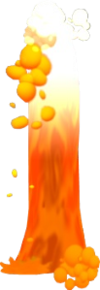
|
Lava Geyser | Lava that rises up from pits. | Meteor Moat | |

|
Lava swell | Lava that moves up in waves. | Iggy's Volcanic Castle | |
 Mecha Hand |
A large mechanical hand modeled after Bowser's own hand that attempts to crush the players while they are on board. | The Mighty Cannonship | Boarding the Airship | |

|
Meteor | Rocks that fall slowly and break upon hitting either the ground or a block. | Meteor Moat | Firefall Cliffs |

|
Poison | A liquid hazard that can cause the player to instantly lose a life. | Bridge over Poisoned Waters | Spinning Platforms of Doom |

|
Quicksand | Sand that sinks the player. | Stone-Eye Zone | Blooming Lakitus |

|
Rising lava | Lava that rises up. | Rising Tides of Lava | |

|
Sand Geyser | Sand that rises up from pits. | Stone-Eye Zone | Spike's Spouting Sands |
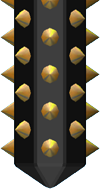
|
Skewer | Spiked Pillars that move up and down. | Giant Skewer Tower | |
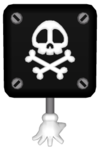
|
Torpedo tube | An indestructable box that fires Torpedo Teds. | Larry's Torpedo Castle | The Mighty Cannonship |
 Torpedo Base |
Red torpedo tubes that fire Targeting Teds instead of Torpedo Teds. | The Mighty Cannonship | ||

|
Water | Large bodies of harmless liquid that the player(s) can swim through. | Blooper's Secret Lair | Swim for Your Life! |
| File:NSMBU Above the Cheep Cheep Seas Screenshot.jpg | Water Geyser | Water that rises up from pits. | Waterspout Beach | Larry's Torpedo Castle |
Items and objects
| Item | Image | Function |
|---|---|---|
| Super Mushroom |  |
Turns Mario into Super Mario. |
| Fire Flower |  |
Turns Mario into Fire Mario. |
| Super Acorn (new) |  |
Turns Mario into Flying Squirrel Mario. |
| Mini Mushroom |  |
Turns Mario into Mini Mario. |
| Ice Flower |  |
Turns Mario into Ice Mario. Mario can shoot ice balls to freeze most enemies. |
| Propeller Mushroom | Turns Mario into Propeller Mario and gives him a short flight. | |
| Penguin Suit |  |
Turns Mario into Penguin Mario. Mario can shoot ice balls and slide on his belly, along with having an improved swimming ability. |
| P-Acorn (new) |  |
Turns Mario into P Flying Squirrel Mario. |
| Super Star | Turns Mario into Invincible Mario. | |
| Boost Star (new) |  |
A star that appears during Boost Mode. |
| 1-Up Mushroom |  |
Gives the player an extra life. |
| 3-Up Moon |  |
Gives the player three extra lives. Only appears in Boost Mode. |
| Coin |  |
Collecting 100 of these gives the player an extra life. |
| Blue Coin |  |
These coins are just like normal coins, but they appear by hitting a P Switch. |
| Red Coin |  |
Collecting all eight Red Coins that appear after passing through a Red Ring gives a Super Mushroom, Fire Flower, or 1-Up Mushroom, depending on what power-up the player is currently using. |
| Green Coin (new) | Collecting all five groups of Green Coins that appear after passing through a Green Ring gives a Super Mushroom, Fire Flower, or 1-Up Mushroom, depending on what power-up the player is currently using. | |
| Hidden Coin |  |
An outline of a coin that becomes a coin if Mario goes through it. These coins are very common in Coin Battle. |
| Star Coin | Three of these are located in every course in hard-to-reach or hidden areas. | |
| Red Ring |  |
Makes eight Red Coins appear. If the player collects all eight coins before they disappear, they receive either a power-up, which varies in between levels, or a 1-Up Mushroom, depending on the player's current size. |
| Green Ring |  |
Makes fifteen Green Coins appear. If the player collects all five groups of green coins before they disappear, they receive either a power-up, which varies in between levels, or a 1-Up Mushroom, depending on the player's current size. |
| Yoshi egg | An egg that Yoshi comes out of or produces after eating five fruits, which contain power-ups. They come in two different colors: green releases a normal green Yoshi; while yellow releases a Glowing Baby Yoshi. As Bubble Baby Yoshi and Balloon Baby Yoshis are found on the world map, they do not come out of eggs. | |
| Fruit | A fruit that Yoshi eats. When Yoshi eats five fruits, he makes an egg that contains an item. | |
| Barrel |  |
An item that Mario can pick up and throw at enemies to defeat them and at coins to collect them. Broozers can also throw them. If another player touches a barrel while it rolls, they lose a life or their power-up. |
| Crate |  |
A wooden box Mario can break via a Ground Pound. Sometimes contains coins or power-ups. |
| Iron Block | An iron box that drops on Conveyor Belts. They are indestructible and causes the player to lose a life if crushed. | |
| Frozen Coin | A coin encased in solid ice that can be melted by fire to be collected. | |
| Flower |  |
A common background object that releases a coin when spun next to. |
| P Switch | File:NSMBW P-Switch Sprite.png | Turns bricks into coins or vice versa, or it causes the revealing of Blue Coins. |
| ? Switch |  |
Changes or adds things to an area, such as platforms, for a limited time. |
| ! Switch |  |
Activating the switch enables the axe and destroy the bridge, causing Bowser to fall. |
| Trampoline |  |
A spring that lets the player jump high into the air. It can be picked up and carried around. |
| Checkpoint Flag |  |
A flag that acts like a checkpoint. It has Bowser's insignia, but if a player touches it, it is replaced by whichever character's symbol turned it. If that character is in their Small form, they transform into their Super form. |
| Goal Pole |  |
Flagpoles found at the end of every level. Touching one completes the level. |
| Goal Pole (secret) |  |
Red flagpoles found at the end of some levels. Touching one completes the level and leads to secret exits. |
Blocks
| Block | Image | Function |
|---|---|---|
| ? Block |     |
Contains a coin or item when hit. |
| Brick |     |
Breaks or contains coins when hit. |
| Coin Block |  |
A block that contains many coins. Looks just like a brick and becomes an Empty Block when used. Pops out five coins when used quickly enough. |
| Flying ? Block | A type of ? Block that flies in a rhythmic pattern to the music of a stage. Once hit, it becomes an Empty Block. | |
| Empty Block |     |
A block that cannot be broken. When a ? Block is hit, it turns into an Empty Block. |
| Mega ? Block |     |
A large ? Block that acts like a normal block. |
| Big Block |     |
A large Brick Block that acts like a normal block. |
| Big Empty Block |     |
A giant block that cannot be broken. When a Mega ? Block is hit, it turns into an Big Empty Block. |
| Jump Block | A block that, when Mario jumps on it, makes him jump higher. | |
| POW Block |  |
A block that causes a large tremor on the ground when thrown. |
| Roulette Block | A block with various items scrolling on it. Mario can hit it and release the power-up shown. | |
| 3-Up Moon Block (new) |  |
An very rare block that contains a 3-Up Moon. |
| Super Guide Block | Appears after Mario dies eight times in a row in one stage. When this block is hit, Luigi clears the stage for Mario. | |
| Boost Block (new) | Blocks that appear when touching the GamePad. | |
| Light Block (new) |  |
A block that shines light in dark areas. |
| Ice Block |  |
A block that is created by an enemy that was frozen with an ice ball. This block can be picked up and thrown like a barrel. |
| Ice Chunk (new) | A giant variant of an Ice Block that serves as a platform. It functions similar to Iron Blocks, which can also crush the player. | |
| Stretch Block |  |
A block made up of five segments that stretches to act as a bridge in certain levels. |
| Donut Block | A platform that falls under weight if Mario stays there for too long. As Mini Mario, he is too light to make it fall; as such, it becomes safer. | |
| Snake Block | Green blocks that move like a snake once Mario steps on it. | |
| Giant Snake Block (new) | Giant variants of a Snake Block. | |
| Hard Block |  |
Block that can only be destroyed by Bob-omb explosions or some large/spiky enemies like Grrrols or Big Thwomps. |
Transportation objects
| Transportation | Image | Function |
|---|---|---|
| Warp Pipe |     |
Pipes going through the ground that transport the player to new areas. |
| Small pipe |     |
Mini variants of warp pipes that can be acessed with a Mini Mushroom. |
| Pipe Cannon |  |
Pipes that launch the player to another location or a hard to reach platform |
| Warp Door |  |
A door found in Ghost Houses, fortresses, and castles that take the player to another portion of the level. Large doors serve as entry points to a boss. |
Climbable objects
| Climbable object | Image | Function |
|---|---|---|
| Beanstalk | Used as a ladder that can lead to Coin Heaven, or a secret place. Grows out of an Invisible Block or Brick Block. | |
| Ladder | File:NsmbuLadder.png | A climbable object used to get on top of platforms. |
| Pole | File:NsmbuPole.png | Striped poles that the player can climb up and slide down after jumping onto them. |
| Chain-Link | 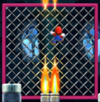 |
Fences that the player can climb. |
Platforms
| Platform | Image | Function |
|---|---|---|
| Bridge | A kind of semisolid platform. | |
| Cloud Lift | Long platforms that move to the right when initially landed on. | |
| Scale Lift |  |
Scale-like platforms that the player lands on one platform, the parallel one rises. It will fall off if they stand on it for too long. |
| Arrow Lift (new) | Lifts that appear blue when idle, but turn red when activated. When activated, they will move in the opposite direction from where they are pointing while idle. | |
| Bolt Lift | File:NsmbuBoltLift.png | A set of nuts that are screwed onto a very long bolt that serve as platforms. The player must continually jump to avoid falling. |
| Screwtop Lift | A lift with a screw that the player can move in a set direction by spinning. | |
| Limited Lift | A lift that the player can travel with a limited capacity of at least five enemies. It stops once the counter reaches 0. | |
| Cross Lift (new) |  |
A lift that expands and contracts horizontally, and also conversely expands and contracts vertically. |
| Slide Lift (new) |  |
Lifts that are aligned either horizontally or vertically and move in a rectangular fashion either clockwise or counterclockwise. |
| Star Lift (new) |  |
Star-shaped platforms that spin depending on which side of them is weighed down by the player. |
| Mushroom Platform |  |
Mushrooms that serve as platforms. |
| Stretch Shroom |  |
Mushroom Platforms that contract and extend at constant intervals, pulling anything and anyone on the ends of the platforms to the center when they contract. |
| Screwtop Shroom | File:NSMBW SpinKinokoLift.png | A rare Mushroom Platform that only appears in Rising Tides of Lava. When spun on, it lowers another lift's height. |
| Seesaw Shroom (new) |  |
A mushroom platform that acts as a seesaw. |
| Bouncy Cloud | Cloud platforms that makes the player and enemies bounces very high. | |
| Remote-Control Platform | A lift that the player can tilt and move on tracks by tilting the Wii Remote. It reacts only when a player is standing on it. | |
| Paddle Platform | A paddle wheel-like platforms made of 4 smaller platforms that moves in a wheel on tracks. | |
| Pendulum Platform | File:NsmbuPendulumPlatform.png | Chained platforms that sway from side to side indefinitely. |
| Screwtop Platform |  |
A platform with a screw that the player can move in a set direction by spinning. |
| Spine Coaster | Rideable creatures made of bone used to aid Mario and company to pass through lava pits. | |
| Water Ball |  |
A huge mass of water that floats in the air. Acts as if Mario and co. are in water. |
| Semisolid Platform |  |
Platforms the player can jump on from the bottom. |
| Leaf Platform (new) |  |
Leaves that serve as platforms appearing on giant beanstalks. When they first sprout, they appear to be green, only to turn red and brown then slowly float down after some time has passed. |
| Bean Platform (new) | File:NsmbuBeanPlatformCurled.png | Large beans serving as platforms that periodically coil and uncoil. |
| Stone-Eye (new) | 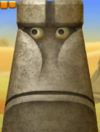 |
Giant gray stone heads that either move in different patterns, or stay completely stationary. Stone-Eyes are sentient, indicated by their eyes that constantly stare at the player. |
| Conveyor Belt | File:NsmbuConveyorBelt.png | Moving platforms that carry the player and sometimes Iron Blocks and enemies. |
| Turning Floor |  |
Continually moving objects that turn clockwise or counterclockwise, moving anything on them. |
| Rolling log |  |
Cylindrical wooden platforms that, when stood on, roll over. The player must run along them or jump carefully to avoid falling off until they reach their destination on a set path. |
| Seesaw Log Bridge (new) |  |
Solid wooden platforms that teeter to one side when a player or element stands on the opposite side. |
| Floor | Platforms that the player can bump from below to stun enemies. | |
| Gear platform |  |
A platform with gears that moves left and right. |
| Wobble Rock | File:NsmbuWobbleRock.png | Rock platforms that wobble from left to right when the player stands near one of its edges. |
| Bridge (new) |  |
A floor made up of skeleton bones. When Bowser Jr. slams down on a bridge with his Junior Clown Car, it causes brief ripples that can stun the player and enemies. |
Differences from New Super Mario Bros. U and New Super Luigi U
General
- It is now possible to play as Luigi, Toad, and Nabbit in single player in this game's version of the main mode of New Super Mario Bros. U, as well as this game's version of New Super Luigi U. The original release of New Super Mario Bros. U only allows single players to play as Mario in story mode, while the original release of New Super Luigi U restricts single players to Luigi, Nabbit (except in Flying Squirrel Ovation and Enemy Courses), and Mii characters (only in Flying Squirrel Ovation).
- The game has a higher resolution, being displayed in native 1080p in TV mode, and 720p in Handheld and Tabletop modes, as opposed to the 720p resolution of the Wii U version.
- New Super Mario Bros. U Deluxe is incompatible with Miiverse, as the service ended prior to the game's release and is not available for the Nintendo Switch.
- Boost Mode challenges are removed due to Boost Mode being incompatible with the Nintendo Switch controls.
- The game uses HD rumble, unlike the original game which uses simple rumble.
- The game is now localized in Korean and Chinese (both simplified and traditional).
Character-specific
- Toadette makes her New Super Mario Bros. series debut as a new playable character.
- The Super Crown is added as a new power-up exclusively for Toadette. Toadette becomes Peachette after touching the Super Crown, which allows her to float and double jump, similar to the Flying Squirrel form (but with a more versatile aerial movement), and avoid falling into fatal objects. However, unlike the Flying Squirrel form, she cannot cling on to walls and she will not descend significantly when turning. Other characters cannot pick it up, merely passing through it without getting rewarded.
- When playing as Toadette, all Blocks containing 1-Up Mushrooms instead contain 3-Up Moons. Only Toadette can hit blocks to reveal them in multiplayer.
- Nabbit has been integrated into more aspects of the game.
- Nabbit can now be played within the New Super Mario Bros. U levels.
- Nabbit has new voice clips that are similar to the Toads.
- Nabbit can bounce off Yoshis since he cannot ride them, unlike the original game where he simply goes through them.
- Nabbit can now carry objects.
- Toadette and Nabbit have altered abilities compared to the rest of the cast.
- Toadette and Nabbit have swimming properties like the Penguin Suit, no matter what form they have.
- Toadette and Nabbit are less slippery than Mario, Luigi, and Toad. Even while running, they will stop sooner and are less likely to fall into pits. They are also resistant to slipping on ice.
- As a result, Toadette and Nabbit are not playable in Challenge Mode.
- Yellow Toad and Blue Toad share a character slot, and are both referred to as simply "Toad". To switch between them, the player needs to hold
while choosing said playable character.
- This means two players cannot choose Yellow and Blue Toad simultaneously.
- When playing as Luigi in New Super Mario Bros. U, a red-colored Super Guide Block appears and summons a computer-controlled Mario to clear the level in place of Luigi.
- Playing as a Mii is no longer possible in Flying Squirrel Ovation within New Super Luigi U.
- Both the New Super Mario Bros. U and the New Super Luigi U levels start with 100 additional seconds on the timer when playing as either Toadette or Nabbit, though no bigger time bonus is given when both of them are being played.
Gameplay
- The jump controls are now shared with the mid-air spin, performed by pressing
or
in mid-air. Players can still spin with the
and
buttons, however.
- The player can disable the mid-air spin for
or
by holding the
down for three seconds on the title screen while pressing the
and
buttons at the same time. When Nabbit's voice is heard, the jump controls have been disabled for the mid-air spin. However, this has to be done each time the game starts up.
- The player can disable the mid-air spin for
- Pressing
no longer lets the player play as Nabbit in New Super Luigi U; this is instead done through the menu.
- Two buttons are now used to go in the bubble during multiplayer by holding down
and
rather than one button, unlike the original Wii U game.
- In the red Toad Houses with ? Blocks, Toad gives the player all of the items inside the blocks that were hit, instead of just one.
- In the pause menu during levels, the controls for the
and
buttons can be reversed; however, nothing else can be remapped.
- On the pause screen, characters can be changed on the map screen.
- A neon Nintendo Switch console appears in the Records Toad House, which plays a music box rendition of the game's credits theme while the credits roll.
- The Records Toad House pages now resemble a map marked with a red stamp depicting a silhouette of Nabbit's ears. "Records" is now renamed to "Mario U Records" and "Luigi U Records" in the American English version, depending on the game being played. As Boost Mode has been removed, the records for "Distance on Boost Blocks" and "Distance on Mini Boost Blocks" have been replaced with "Times Companion Lifted" and "Synchronize Ground Pounds", respectively, along with updated icons.
- In New Super Mario Bros. U Deluxe, the red Toad Houses with the shuffle mini-games have some items changed. Several Super Stars have been replaced by Super Crowns, while in New Super Luigi U, the 1-Up Mushrooms are now 3-Up Moons.
- Enemy Courses now have a chance to hold a Super Crown, a Propeller Mushroom, or a Penguin Suit.
- In New Super Mario Bros. U Deluxe, the stars on the player's profile will remain shiny, even if the player activated the Super Guide before.
Cutscenes
- In both the ending and the cutscene where Peach is being rescued, Nabbit always appears in the background, regardless of what character(s) was/were used in the final boss battle.
- Blue Toad is absent from the introduction and ending cutscenes, with Toadette appearing instead. Yellow Toad is the one who watches Bowser's and the Koopalings' escape in the ending (Blue Toad does this in the original versions).
- Before fighting Bowser's final phase as Peachette, Peach notices Peachette from her tower looking confused just before the window slams shut.
UI and artwork
- The buttons for Challenges, Boost Rush, and Coin Battle on the main menu have artwork of Mario thinking, Mario running, and a Star Coin, respectively, replacing the Super Mario Bros. sprites seen on the buttons in the original New Super Mario Bros. U.
- Character selection icons now use their updated artwork. Toadette and Nabbit are also labeled as "Easier" and "Easiest" ("Easy" and "Very Easy" in the British English version) respectively.
- The title screen uses the same ground as the New Super Luigi U title screen with Nabbit included.
- The loading screen's background uses different 2D icons.
- Save files now show the last played character.
- The challenges menu has been redesigned.
- There is now a hint button on the menu.
- When entering a world, the name of the map has a different banner design, with 2D artwork of blocks in outlines.
- In this game's version of New Super Mario Bros. U, the button tabs on the map are red instead of blue. This game's versions of both New Super Mario Bros. U and New Super Luigi U use button icons of the Switch controllers. Additionally, the player can also use
to open the menu.
- Nabbit's icon marker on the map for chasing him has been updated.
- In the Baby Yoshi minigame for the Power-Up Toad House, the Glowing Baby Yoshis' Toad icon has been updated to resemble Toad's 2D artwork from Super Mario 3D World, but with red spots.
- When playing as Nabbit in single player, completed level spaces turn purple instead of blue. If the level is completed again with a character other than Nabbit, the space changes from purple to blue.
- The movement instruction icons when using motion-controlled platforms have Joy-Con/Pro Controllers instead of Wii Remotes.
- The Game Over and "Continues Used" screens are flatter and overall less detailed.
Audio
- The audio quality of the music has been increased; all tracks now have a sample rate of 48 kHz instead of 32 kHz.
- In the second half of the athletic theme, the melody instrument is now stereo instead of mono.
Sound effects and voices
- Bony Beetles now have sound effects when they stick out or retract their spikes.
- Boom Boom and Boss Sumo Bro's voices sound slightly different.
- The Super Guide Block's bell sounds different.
- The Missile Bills, fired from Roy Koopa's cannon, have different beeping sounds.
- Nabbit's voice clips are different compared to the original.
Promotion
A browser game was released on the Play Nintendo website in 2019 called New Super Mario Bros. U Deluxe Power-Ups Trivia Quiz.
Critical reception
Similarly to the original New Super Mario Bros. U, New Super Mario Bros. U Deluxe has received generally positive reviews from critics.
| Reviews | |||
|---|---|---|---|
| Release | Reviewer, Publication | Score | Comment |
| Nintendo Switch | Blake Morse, Shacknews |
8/10 | New Super Mario Bros. U Deluxe isn't without its faults. I really think that the levels needed to be longer or provide a bit more of a challenge for seasoned players as opposed to watering things down for a younger audience who probably could've handled a regular challenge in the first place. I can't help but feel like so much of this game was spoon fed to me. I definitely finished this a heck of a lot quicker than I had any previous Mario games. Maybe it's because I grew up having my mind blown by Super Mario Bros. 3 and Super Mario World, but side-scrolling Mario games have always had a place in my heart. While I wouldn't put this latest entry on the same pedestal, this is still a very solid game with a lot of what we've all come to love about the series thrown into a melting pot. I don't think Nintendo would ever put out a "bad" Mario, honestly. There's plenty here to keep fans and next of kin busy and entertained for quite some time. |
| Nintendo Switch | Tristan Ogilvie, IGN |
8/10 | New Super Mario Bros. U Deluxe is a broadly approachable and feature-rich platforming game. Toadette is a welcome addition to the roster for those after a more forgiving way to tackle some of the more challenging levels, and the inclusion of the New Super Luigi U mode extends its lifespan substantially. While there are a number of other Nintendo Switch games within the genre that outdo New Super Mario Bros. U Deluxe in various different ways, it nonetheless remains a highly enjoyable platforming package as a whole. |
| Nintendo Switch | Gavin Lane, Nintendo Life |
8/10 | New Super Mario Bros. U Deluxe is an impressive package if you skipped the original, offering the best of modern-era 2D Mario, madcap multiplayer and glimpses of the outrageous invention that was to come in Super Mario Odyssey. Only the most fervent fans will find enough new content here to justify double-dipping, though, especially if you already played the Luigi expansion. The chance to replay a top-drawer Mario game on a handheld may be enough for some – goodness knows we've rebought Super Mario Bros. 3 enough times! – but this is the oldest of the Wii U games to have found new life on Switch and, gameplay aside, ageing visuals and the colossal irritation of being kicked back to the world map after every death stand out as things in need of attention. The bottom line is that Switch now has a very fine 2D Mario to its name; we just can't help feeling disappointed that Nintendo didn't push the boat out with a more thorough 'Deluxe' refurbishment. Having said that, this is still an excellent package that deserves a new lease of life on Switch, especially as there will be many owners of that console who didn't get to experience the Wii U original and its expansion. |
| Nintendo Switch | Oscar Dayus, GameSpot |
7/10 | Despite its aging formula, New Super Mario Bros. U Deluxe is still a great entry in the series, with its typically tight platforming and both accessibility and depth to spare. While it can feel a bit stale for those who have been round the Mushroom Kingdom one too many times before, Deluxe is well worth playing, especially if you didn't get a chance to play NSMBU on Wii U. |
| Aggregators | |||
| Compiler | Template:Nowrap | ||
| Metacritic | 80 | ||
| GameRankings | 79.93% | ||
Sales
As of March 31st, 2024, the game had sold 17.45 million units worldwide.[1]
Updates
Release date: November 18, 2012
Released at launch, the first update adds the game's Miiverse functionality.
Release date: March 15, 2013[2]
The second update causes any Miiverse posts made in-game to be posted to a separate "Game Posts" community rather than the standard community.
Release date: June 20, 2013[3]
The third game update adds the ability for the game to receive the New Super Luigi U downloadable content and puts a prompt in-game to go to the Nintendo eShop to download it. The update also adds support for the Wii U Pro Controller.
Development
As stated above, New Super Mario Bros. U was based upon the New Super Mario Bros. Mii Wii U experience demo shown off at E3 2011.[4] A translation of a Spanish online magazine revealed that the new title was in development and would be revealed at E3 2012,[5] with the game fully revealed to be New Super Mario Bros. U during the E3 trailer.[6]
New Super Mario Bros. U began development soon after the completion of New Super Mario Bros. Wii, using pre-existing elements from the Wii game, as development equipment for the Wii U did not exist at the time.[7] The game's singular, interconnected world map was inspired by the one seen in Super Mario World; Masataka Takemoto desired to take the map from that game and use the Wii U in order to recreate and expand upon the concept.[8] The map being seamless also had a role in Miiverse integration, as with the setup of the map it was possible to display comments across each of the levels.[9] The concept of drop-in play with one player on the Gamepad placing blocks was brought up early in development. When the Wii U Gamepad was brought up during development, the team began to conceptualize ways to use it, talking specifically about the drop-in play. Wanting to make a feature with "controls that you can understand right away with no explanation," the concept of using the GamePad to place blocks the other players can jump on went through.[7]
Challenge Mode was based upon the idea of setting a self-challenge in the previous games, as well as the challenge site for New Super Mario Bros. Wii. Because of ideas like this, the developers decided to put the Challenge Mode into the game from the beginning. The challenges were created with all types of skill levels in mind.[10]
Boost Rush Mode was based on the Free-for-All Mode featured in New Super Mario Bros. Wii, in that they wanted a similar mode for playing the main game stages in short bursts. The developers tried connecting courses together and playing them through, but found it uneventful; they then added the concept of collecting coins resulting in the screen scrolling faster, and found it to fit a Super Mario-style of gameplay.[8]
Pre-release and unused content
During the September 2018 Nintendo Direct, Mario was shown being used in Waddlewing Warning! and Larry's Trigger-Happy Castle, two New Super Luigi U levels.[11] However, Mario is not playable in the New Super Luigi U levels in the final game, as is the case in the original New Super Luigi U.
Gallery
- For this subject's image gallery, see Gallery:New Super Mario Bros. U Deluxe.
Staff
- Main article: List of New Super Mario Bros. U Deluxe staff
References to other games
- Mario Tennis Aces: Toadette's voice clips are reused from this game.
References in other games
- Super Smash Bros. Ultimate: An event called "Super Smash Sisters" was held, which introduced Peachette as a spirit.
- Mario Kart Tour: Peachette and Penguin Toadette appear as playable characters, with the former reusing her artwork and her emblem being a Super Crown.
- Mario Kart 8 Deluxe: Wave 6 of the Booster Course Pass introduced Peachette as a driver.
Names in other languages
| Language | Name | Meaning | Notes |
|---|---|---|---|
| Chinese (simplified) | New 超级马力欧兄弟U 豪华版 (Global release) New Chāojí Mǎlìōu Xiōngdì U Háohuábǎn 新 超级马力欧兄弟U 豪华版 (China release)[12] Xīn Chāojí Mǎlìōu Xiōngdì U Háohuábǎn |
New Super Mario Brothers U Deluxe Edition | |
| Chinese (traditional) | New 超級瑪利歐兄弟U 豪華版[13] New Chāojí Mǎlìōu Xiōngdì U Háohuábǎn |
New Super Mario Brothers U Deluxe Edition | |
| Korean | 뉴 슈퍼 마리오브라더스 U 디럭스[?] Nyu Syupeo Mario Beuradeoseu U Direokseu |
New Super Mario Bros. U Deluxe |
References
- ^ Nintendo (May 7, 2024) Top Selling Title Sales Unites. Nintendo Japan. Retrieved May 7, 2024. Archived from the original on May 7, 2024.
- ^ Bonds, Curtis (March 15, 2013). v.1.2.0 Released for New Super Mario Bros. U. Nintendo World Report. Retrieved November 28, 2014.
- ^ New Super Mario Bros. U Update Allows Wii U Pro Controller Use. My Nintendo News (June 20, 2013). Retrieved November 28, 2014.
- ^ Mario Wii U "Based On" New Super Mario Bros. Mii Wii U News @ Nintendo Life
- ^ Miyamoto To Show Wii U Mario at E3 - Wii News @ Nintendo Life
- ^ Wii U - New Super Mario Bros. U E3 Trailer
- ^ a b Iwata Asks : New Super Mario Bros. U : "What Should Be New?"
- ^ a b Iwata Asks : New Super Mario Bros. U : One Map
- ^ Iwata Asks : New Super Mario Bros. U : Reading the Posts in your Hands
- ^ Iwata Asks : New Super Mario Bros. U : "Mottainai (What a Waste)!"
- ^ https://youtu.be/6wTFy-pJFMI?t=37
- ^ Official Chinese game page
- ^ Nintendo HK

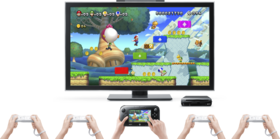
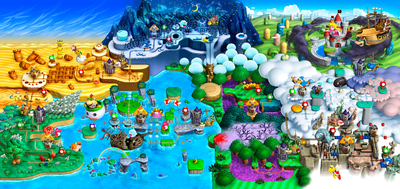
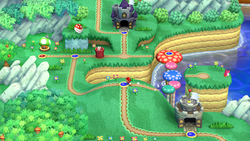
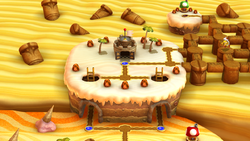

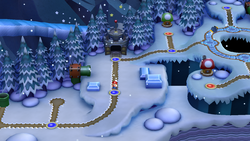

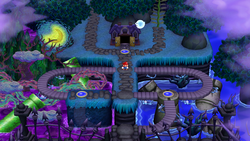

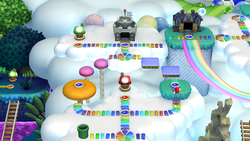
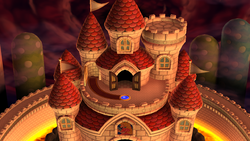
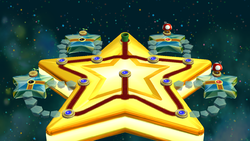
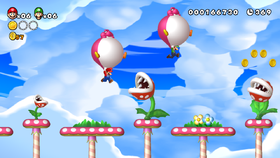
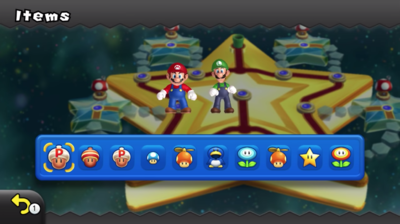
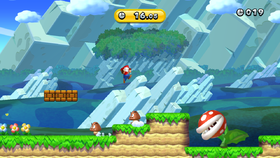


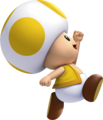
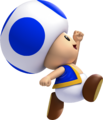



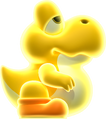
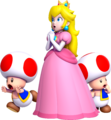


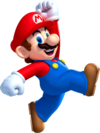
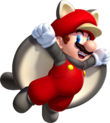
![Artwork of Fire Mario in New Super Mario Bros. (also used in New Super Mario Bros. Wii and Super Mario 3D Land)[1][2]](https://mario.wiki.gallery/images/thumb/8/8a/Fire_Mario.png/185px-Fire_Mario.png)
